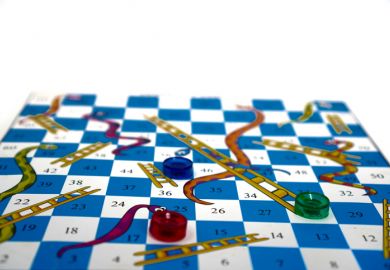Source: Kobal
You rub my back: a ‘superb’ lecturer and a ‘successful’ student can’t fail to be a winning combination
Academics and students are tacitly trading light workloads and lenient marking for higher teaching evaluation scores, a study claims.
This unspoken “disengagement compact” helps to explain why student evaluation of teaching (SET) scores at US universities have generally increased while teaching hours have fallen since the 1960s, according to academics at Central Michigan University.
Writing in this month’s edition of Assessment & Evaluation in Higher Education, James Felton and John B. Mitchell, both professors of finance, Peter T. Koper, emeritus professor of English, and Kenneth J. Sanney, assistant professor of business law and regulation, claim that the use of student satisfaction surveys is also the primary cause of grade inflation over the past four decades.
At the heart of the problem is that lecturers’ careers are often dependent on achieving high teaching evaluation assessments from students looking for “easy courses with inflated grades”, it is argued.
“Faculty who lighten workloads and inflate grades buy high SET ratings and popularity for their courses, hence professional security to the extent that such measures affect personnel decisions,” the academics argue.
Lecturers also benefit from setting lighter workloads for students because they are not required to spend endless hours reading and carefully annotating essays, thereby creating time for research which “gets them institutional recognition and promotion”, it adds.
“The disengagement pact is a tacit agreement by professors to go easy on workload and grading if students will go easy on SETs and demands on the instructor’s time,” the scholars say.
They cite a 10-year study of students in the US Air Force Academy, who are required to take a calculus module before sitting a common final examination.
Students who achieved higher grades in the calculus exam gave their instructors higher evaluations, but it was students with more rigorous graders who tended to do better in the long run, the study says.
“Student evaluations reward professors who increase achievement in the contemporaneous course being taught, not those who increase deep learning,” the study concludes.
Senior faculty were also far more likely to be tough markers than those on a temporary contract, it also finds.
To combat grade inflation, the authors propose the introduction of a “real grade point average”, in which a student’s final degree result sits alongside the average mark achieved within their year.
This would “encourage and protect faculty and students who offer or seek out educational experiences that have not been deflected by greed, sloth or cowardice”, they say.
In addition, a “real SET” score, where their satisfaction score was adjusted depending on how hard they marked throughout the course, could be introduced, they claim in the article, titled “Real GPA and real SET: two antidotes to greed, sloth and cowardice in the college classroom”.
“A faculty member acting alone to tighten grading or workload faces real and, if the individual is untenured, threatening pressures” that risk “endangering their careers”, they state.
The two measures proposed would “make visible the relative inflation of the classes’ grading and might generate some quiet pressure to not be visibly inflationary”, they suggest.
Register to continue
Why register?
- Registration is free and only takes a moment
- Once registered, you can read 3 articles a month
- Sign up for our newsletter
Subscribe
Or subscribe for unlimited access to:
- Unlimited access to news, views, insights & reviews
- Digital editions
- Digital access to THE’s university and college rankings analysis
Already registered or a current subscriber? Login





